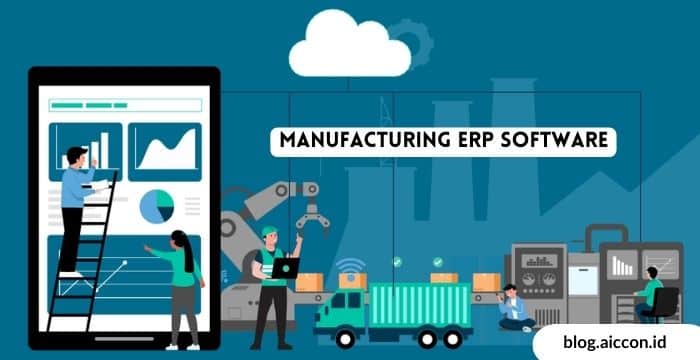I. Introduction
blog.aiccon.id | Manufacturing ERP Software – In the intricate world of manufacturing, where every component, process, and decision counts, Enterprise Resource Planning (ERP) software emerges as a beacon of order in the chaos. At its core, ERP software is the digital orchestration of a manufacturing enterprise’s resources, ensuring efficiency, accuracy, and seamless operations. This article embarks on a journey into the heart of manufacturing ERP, revealing its transformative potential. We will explore how ERP software isn’t just a tool but a strategic imperative for manufacturers, unraveling its myriad benefits, and uncovering the blueprint for successful implementation.
II. The Role of ERP in Manufacturing
Manufacturing is a symphony of moving parts, where precision is paramount. It’s a sector with its own set of complexities, including managing supply chains, inventory, production schedules, and quality control. ERP steps onto this stage as the conductor, orchestrating every element with precision. It provides manufacturers with the capability to streamline processes, reduce waste, enhance quality, and gain a competitive edge in a global market.
III. Key Features of Manufacturing ERP Software
Within the manufacturing ERP arsenal lie crucial features designed to meet industry-specific needs:
- Production Planning and Scheduling: Seamlessly coordinate manufacturing processes, from order placement to product delivery.
- Inventory Management: Maintain optimal stock levels, reduce holding costs, and ensure materials are readily available.
- Quality Control: Monitor product quality at every stage to meet strict industry standards.
- Supplier and Vendor Management: Build stronger relationships with suppliers, ensuring a steady supply of materials.
- Shop Floor Tracking: Gain real-time visibility into production progress and identify bottlenecks for immediate action.
IV. Benefits of Manufacturing ERP Software
- Improved Production Efficiency: ERP streamlines operations, reducing manual interventions and errors.
- Real-time Data Insights: Access to up-to-the-minute data enables informed decision-making.
- Cost Savings and Waste Reduction: Enhanced resource allocation and waste reduction lead to substantial savings.
- Enhanced Quality Control: Consistent product quality elevates brand reputation.
- Supply Chain Visibility: End-to-end visibility ensures a smoother, more resilient supply chain.
As we delve deeper into the world of manufacturing ERP software, the promise of efficiency, precision, and competitiveness becomes increasingly evident. Stay with us as we explore its implementation intricacies, share real-world success stories, glimpse into the future trends, and ultimately pave the way for manufacturers to embark on a journey towards excellence.
V. Implementation of Manufacturing ERP Software
Implementing ERP software in a manufacturing setting is a multifaceted endeavor. To ensure a smooth transition and maximize its benefits, several factors must be carefully considered. The first step is selecting the right ERP system that aligns with your manufacturing needs, followed by meticulous planning. Data migration, often involving vast amounts of historical data, requires special attention to avoid disruptions. Employee training is equally vital; a well-trained workforce ensures the system is used effectively. Best practices for a successful ERP implementation in manufacturing include involving key stakeholders from the beginning, setting realistic timelines, and having a contingency plan in case of unexpected challenges.
VI. Industry-Specific Applications
One of the remarkable aspects of manufacturing ERP software is its adaptability to various sectors within the industry. In automotive manufacturing, ERP aids in optimizing production lines, reducing downtime, and improving supply chain coordination. In electronics manufacturing, it ensures precise inventory management and compliance with stringent quality standards. In the food industry, ERP supports batch traceability, ensuring food safety and regulatory compliance. Each manufacturing sector finds tailored solutions within ERP software, resulting in improved efficiency, reduced costs, and enhanced product quality.
VII. Real-World Success Stories
Real-world success stories serve as inspiring beacons of the potential held within manufacturing ERP software. Consider Company X, a medium-sized electronics manufacturer, faced with rising production costs and quality control issues. Implementing ERP allowed them to streamline inventory management, leading to a 30% reduction in excess stock and a 15% increase in on-time deliveries.
Company Y, a food processing company, grappled with compliance challenges due to stringent regulations. ERP not only ensured compliance but also improved traceability, enabling them to respond swiftly to recalls and reducing quality control costs by 20%.
VIII. Future Trends in Manufacturing ERP Software
The future of manufacturing ERP software is bright, with Industry 4.0 integration at the forefront. This includes the convergence of physical and digital systems, IoT integration for real-time monitoring, and AI-driven predictive maintenance. As the manufacturing landscape becomes increasingly digital, data security and compliance will play pivotal roles, ensuring that sensitive information remains protected while adhering to ever-evolving regulations.
IX. Conclusion
In conclusion, manufacturing ERP software isn’t just a tool; it’s a catalyst for transformation within the industry. Its implementation demands meticulous planning, but the rewards are immense—improved efficiency, cost savings, and enhanced competitiveness. As we wrap up our exploration of manufacturing ERP, I encourage manufacturing professionals to seize the opportunity. Embrace the digital age, explore ERP solutions, and embark on a journey towards a more efficient, agile, and competitive future in manufacturing. The path to success begins with ERP; are you ready to take the first step?
